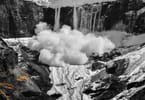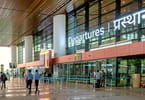As I veer right on the dirt path through the jungle, a howler monkey lets out a spine-chilling roar above me and I spot my first Maya temple.
Framed by damp vegetation, towering El Gran Jaguar, also known as Temple I at the Tikal ruins of Guatemala, looks massive and mysterious, gray stone mottled with green moss.
This famous Maya site, on my must-see-before-I-die list for years, doesn’t disappoint.
In light of the financial meltdown in New York, my visit to one of the greatest capitals of the collapsed Maya civilization seems an appropriate end to 2008, a way to put things in perspective. Plus this Central American country, once mired in civil war, is now a tourism hot spot that boasts boutique hotels yet remains a highly affordable destination. Another bonus: One of the world’s best rums, Zacapa, is made here.
So, on my five-day December trip, after learning to cut sugar cane at a rum distillery and exploring Spanish colonial ruins in historic Antigua, I head for Tikal. My 10 a.m. flight from Guatemala City to the northern province of Peten is only 50 minutes, less time than it takes me to navigate the choking Central American traffic on the way to the airport.
Tikal National Park lies in Peten’s jungle lowlands on the edge of the immense Maya Biosphere Reserve, created in 1990 to preserve the largest — though shrinking — rain forest in Central America, its exotic wildlife and a dozen Maya sites.
A bus to the park’s entrance (admission $20) and visitor center 10 miles farther takes an hour. The road skirts vast, crocodile-laden Lake Peten-Itza and is lined with small fruit stands and road signs warning us to beware of jaguars.
Spider monkeys
Winding jungle paths lead to the huge site, which is blissfully free of commercialism. I spot colorful toucans and spider monkeys swinging from tree to tree as I follow my guide to Tikal’s heart, the Great Plaza, where I’m awestruck by Temple I, a nine-level step pyramid about 20 stories high. Photographs don’t convey its soaring monumentality. Visitors no longer can climb to the tiny room at the top because several died after tumbling down the steep, moss-covered steps.
Guatemalan families picnic on this wide grassy space framed by a sprawling complex of limestone structures — palaces, altars, tombs and Temple I facing Temple II. As kids play hide-and-seek behind carved stone stelae, I try to imagine this as the teeming metropolis it was in 800 A.D. Then, it was a rich and powerful city-state of 100,000 people spread over 25 square miles whose kings pierced their penises with stingray spines before going to war. It had written language, calendars and mathematics. Its priests could predict eclipses, yet a hundred years later the city was silent, abandoned, swallowed up by the jungle.
Tallest temple
A wooden stairway leads to the top of Temple II, though I decide to save my energy for Temple IV. At 212 feet (65 meters), it’s the site’s tallest structure, a 10-minute walk along an ancient Mayan causeway. Luckily, today is cool and cloudy, with a few sprinkles of rain. December through February are the best times to come. By March and April, temperatures can hit 95 degrees, and the steamy air swarms with mosquitoes.
My guide, Edin, an archaeology student at the University of San Carlos, said an ornithologist checking on falcons nesting on Temple IV noticed a crack through its center last November. Restoration started immediately. I huff and puff my way up the sturdy wooden stairway that leads to the top for knockout views of the jungle, with temple roofs poking above the green sapodilla and mahogany trees. It gives me some idea of how the site’s discoverers must have felt a century and a half ago.
Mysterious end
Why Maya civilization collapsed is a question that has long perplexed scholars. Current thinking is that it was a confluence of factors, including drought, deforestation, overuse of land, overpopulation, increased warfare, poor leadership, climate change. Does some of that sound familiar?
I regret that I didn’t plan to stay in one of the modest hotels in the park, even if the electricity goes off at 9 p.m. Yet as I return to my five-star hotel ($190 a night) built in the ruins of a 16th-century monastery in Antigua, I’m delighted all over again.
I wander the Casa Santo Domingo’s courtyard walkways and stone remains of a cathedral lit by votive candles. Gregorian chants playing softly on speakers and splashing fountains create a soothing, meditative atmosphere for reflection on ruins. I jet home tomorrow, but I’m hanging on to the long view for 2009.
WHAT TO TAKE AWAY FROM THIS ARTICLE:
- In light of the financial meltdown in New York, my visit to one of the greatest capitals of the collapsed Maya civilization seems an appropriate end to 2008, a way to put things in perspective.
- Tikal National Park lies in Peten’s jungle lowlands on the edge of the immense Maya Biosphere Reserve, created in 1990 to preserve the largest — though shrinking — rain forest in Central America, its exotic wildlife and a dozen Maya sites.
- flight from Guatemala City to the northern province of Peten is only 50 minutes, less time than it takes me to navigate the choking Central American traffic on the way to the airport.






















